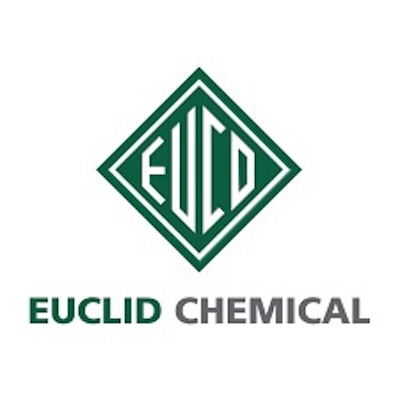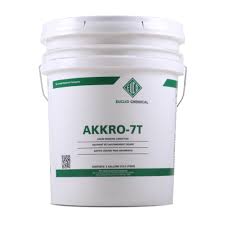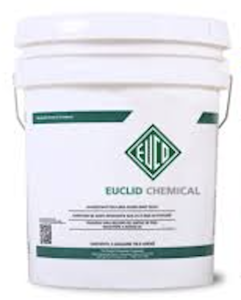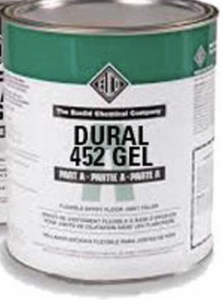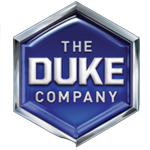LOOKING FOR BONDING AGENTS FOR CONCRETE?
EUCLID CHEMICAL – THE PRO’S GO TO SOLUTION FOR CONCRETE BONDING AGENTS!
BUILDING SUPPLIES | CONCRETE | CSI 03 0000|
EQUIPMENT RENTAL | BUILDING SUPPLIES | CONCRETE FORMING SYSTEMS | ICE CONTROL| ROLLOFF CONTAINERS
ROCHESTER, ITHACA, DANSVILLE & AUBURN NY
Looking to buy Concrete Bonding Agents? The Duke Company carries the complete line of Euclid Chemical concrete bonding agents for the toughest job sites. They are the Pro’s go-to choice to increase flexural, tensile and bond strength and rescue shrinkage and water penetration. Need assistance? Call The Duke Company’s friendly Professional Building Supplies experts for exceptional customer service and expert advice!
Features & Benefits of Euclid Chemical Concrete Bonding Agents
- Increases flexural and tensile strength
- Improves bond strength
- Reduces shrinkage
- Resists water penetration
- Protects against freeze-thaw damage
Concrete Bonding Agents – Euclid Chemical
AKKRO-7T – Acrylic Latex Liquid Bonding Admixture by Euclid Chemical
AKKRO-7T is a non-redispersable, liquid bonding admixture used to produce polymer modified concrete and mortar. AKKRO-7T is a milky white, water-based emulsion of high solids acrylic polymers and modifiers. AKKRO-7T is non-yellowing and has excellent resistance to ultraviolet degradation, heat and most common chemicals. AKKRO-7T does not alter the color of the mixture.
Primary Applications:
- Cement based coatings, toppings, patching mortars, leveling compounds, stucco, and terrazzo
- Mixing liquid for TAMOSEAL, CONCRETE FINISHER, TAMMS SBC and TAMMS STUCCO FINISH
Features and Benefits:
- Increases flexural and tensile strength
- Improves bond strength
- Reduces shrinkage
- Resists water penetration
- Protects against freeze-thaw damage
- Non-yellowing
- Does not re-emulsify when exposed to water
Techical Information
|
Property |
Unmodified Sand-Cement |
Sand-Cement with Akkro-7T |
|
Compressive Strength, psi (MPa) ASTM C109 |
3 days: 1,640 (11.3) 7 days: 2,345 (16.2) |
3 days: 2,890 (19.9) 7 days: 3,410 (23.5) |
|
Flexural Strength, 7 days, psi (MPa) ASTM C78 |
410 (2.8) |
1,096 (7.6) |
|
Bond Strength, 7 days, psi (MPa) ASTM C321 |
56 (0.4) |
486 (3.3) |
|
Tensile Strength, 7 days, psi (MPa) ASTM C190 |
246 (1.7) |
510 |
Directions for Use:
- Surface Preparation: Surface must be structurally sound, clean, free of dust, dirt, oil, curing or form release compounds, paint, laitance, efflorescence and other contaminants. New concrete and masonry surfaces must be cured for at least 7 days. Provide an absorptive surface on smooth precast or formed concrete by abrading the surface. Follow the surface preparation directions for the product in which AKKRO-7T is being used as an admixture.
- Mixing: Stir AKKRO-7T slowly and thoroughly using slow speed mixing equipment and a clean container. Do not aerate the AKKRO-7T.
- Recommended Mixtures:
- Bonding Slurry: Dry mix 1 part portland cement with 3 parts dry sand and add undiluted AKKRO-7T to produce a pourable slurry coat. Brush mixture thoroughly into voids and pores of surface to eliminate air pockets. Before slurry coat dries, follow immediately with patching materials that are compatible with portland cement.
- Patches, Overlays And Toppings: For depths 1/2 in (12.7 mm) or greater, mix 1 part AKKRO-7T with 3 parts potable water. Proportion dry sand, cement, aggregate and add measured amount of mixing liquid. Featheredging and repairs less than 1/2 in (12.7 mm) deep will require additional AKKRO-7T in the mix.
- Terrazzo: Make up a mixing liquid of 1 part AKKRO-7T to 3 parts potable water.
- Thin Coat Wall Applications: Manufactured wall coatings including TAMOSEAL, CONCRETE FINISHER, TAMMS SBC, and TAMMS STUCCO FINISH; mix 1 part AKKRO-7T to 3 parts potable water for mixing liquid, or as directed in instructions for mixing coating.
- Field Mixed Stucco: Mix 1 part AKKRO-7T to 3 parts potable water.
- Cement Plaster Coatings: Applications 3/8 in (9.5 mm) or less; use 1 part AKKRO-7T to 2 parts potable water. Applications over 3/8 in (9.5 mm); use a 1:3 mixture.
- Pointing Mortars: Manufactured tuckpointing mortars and other special mortars for thin applications; mix 1 part AKKRO-7T to 3 parts potable water for mixing liquid.
- Application: Use only light pressure on trowel and finish with as few strokes as possible. Keep trowel clean and wet to prevent sticking. Do not over trowel. Mixes with AKKRO-7T do not normally require curing, but on hot, dry or windy days, it is advisable to cover with moist burlap for 24 hours or as recommended. Air-cure the surface for 2 to 4 days for normal use, and 4 to 7 days for heavy traffic areas. Refer to “PRECAUTIONS,” for curing water containment structures.
TAMMSWELD – Re-wettable Latex Bonding Agent for Concrete by Euclid Chemical
TAMMSWELD is a rewettable liquid bonding agent and polymer modifier for concrete and cement mortars. TAMMSWELD is a high film build, ethylene vinyl acetate copolymer emulsion.
Features & Benefits
- High build bonding agent or polymer admixture
- Increases bond strength
- Improves durability
- Long open time
Applications
- Concrete
- Concrete block
- Plywood
- Brick
- Plaster
- Hardboard
- Tile
- Gypsum board
- Wood
- Stone
- Lath
- Interior and exterior surfaces
Technical Information
|
Physical Property |
Value |
|
Solids Content (by weight) |
34% |
|
Unit Weight, Specific Gravity |
8.9 lbs/gal, 1.07 |
|
VOC Content |
< 5 g/L |
|
Viscosity |
500 to 1,000 cp |
Directions for Use:
- Surface Preparation: Surface must be clean, dry and structurally sound. The substrate must also be free of all curing compounds, form release agents and any other contaminants, which may prevent the proper adhesion of TAMMSWELD. The preferred method of surface preparation is mechanical abrasion. For oil-contaminated surfaces, using steam cleaning in conjunction with a strong emulsifying detergent may be considered. Rinse thoroughly with potable water. Allow the concrete to dry before applying TAMMSWELD.
- Application, Bonding Agent: Stir TAMMSWELD thoroughly before use. Do not dilute. For hand application, wet brushes or rollers before use and shake out excess water. For larger areas or faster application, use airless spray equipment with 0.015 in. to 0.020 in. (0.38 to 0.51 mm) orifice size spray tips. Hold spray gun 12 to 18 inches (30 to 46 cm) from the surface and apply TAMMSWELD using a cross coat technique consisting of a horizontal pass followed by a vertical pass. Extremely porous surfaces may require two coats of TAMMSWELD.
- Allow the TAMMSWELD to dry before placing repair mortars, concrete, or toppings. TAMMSWELD will dry in approximately one hour depending on the temperature and humidity. If more than 7 days pass between TAMMSWELD application and placement of the concrete, topping, or mortar, check several areas to ensure adequate adhesion. Make test applications on questionable surfaces.
- Application, Polymer Modifier: When using TAMMSWELD to produce a polymer modified mortar, add approximately 3 gal (11.36 L) of TAMMSWELD per 100 lbs (45.4 kg) of cement content in the mortar material. The properties achieved by using TAMMSWELD as a polymer modifier will vary depending on the composition of the mortar, and a thorough evaluation of properties should be completed prior to using the polymer modified mix.
DURAL 452 GEL – ASTM C881 Compliant, Non-Sag, High Modulus Epoxy Adhesive by Euclid Chemical
DURAL 452 GEL is a two-component, 100% solids, DOT non-corrosive, moisture insensitive, high strength epoxy adhesive and binder for numerous applications. This high modulus, structural gel is perfect for bonding applications that require a non-sag adhesive.
Primary Applications:
- Bonding of concrete, masonry, steel, or wood
- Anchoring bolts, dowels, or pins
- Pick-proof sealant for jails/prisons and kennels
- Seals cracks and sets ports prior to injection
- Mix with sand to create a repair mortar
Features & Benefits:
- Exceptional adhesion to construction materials
- Easy to use 1:1 mix ratio by volume
- Moisture insensitive
- Superior strength
Technical Information:
|
Property |
Result |
|
Consistency ASTM C881 |
1/8” (3.2 mm) |
|
Gel Time, minutes ASTM C881 |
30 |
|
Bond Strength, psi (MPa) ASTM C882 |
2 days: 2,500 (17.2) 14 days: 3,250 (22.4) |
|
Water Absorption ASTM D570 |
24 hours: 0.2% |
|
Heat Deflection Temperature ASTM D648 |
120°F (50°C) |
|
Linear Coefficient of Shrinkage ASTM D2566 |
0.002 |
|
Compressive Yield, psi (MPa) ASTM D695 |
7 days: 10,250 (70.7) |
|
Compressive Modulus, psi (MPa) ASTM D695 |
7 days: 600,000 (4,137) |
|
Reinforcing Steel |
Threaded Rod |
||||||
|
Rebar Diameter |
Hole Diameter |
Embedment Depth |
Pull-Out Strength* |
Rod Diameter |
Hole Diameter |
Embedment Depth |
Pull-Out Strength* |
|
#4: 1/2”(13 mm) |
5/8”(16 mm) |
4.5”(11.4 cm) |
16038 lbf (71.3 kN) |
3/8” (10 mm) |
1/2” (13 mm) |
3.5” (8.9 cm) |
6388 lbf (28.4 kN) |
|
#5: 5/8”(16 mm) |
3/4”(19 mm) |
5.5”(14.0 cm) |
27378 lbf (121.8 kN) |
1/2” (13 mm) |
5/8” (16 mm) |
4.5” (11.4 cm) |
13103 lbf (58.3 kN) |
|
#6: 3/4”(19 mm) |
7/8”(22 mm) |
6.5”(16.5 cm) |
34504 lbf (153.5 kN) |
5/8” (16 mm) |
3/4” (19 mm) |
5.5” (14.0 cm) |
26665 lbf (118.6 kN) |
|
#7: 7/8”(22 mm) |
1”(25 mm) |
7.5”(19.1 cm) |
45771 lbf (203.6 kN) |
3/4” (19 mm) |
7/8” (22 mm) |
6.5” (16.5 cm) |
34180 lbf (152.0 kN) |
|
#8: 1”(25 mm) |
1 1/8”(29 mm) |
9”(22.9 cm) |
55625 lbf (247.4 kN) |
7/8” (22 mm) |
1” (25 mm) |
7.5” (19.1 cm) |
42914 lbf (190.9 kN) |
|
— |
— |
— |
— |
1” (25 mm) |
1 1/8” (29 mm) |
9.5” (24.1 cm) |
57794 lbf (257.1 kN) |
*Direct tension pull-out strengths were obtained at 7 days, in accordance with ASTM E488.
Directions for Use:
- Surface Preparation: The surface must be structurally sound, dry, clean and free of grease, oil, curing compounds, soil, dust and other contaminants. Surface laitance must be removed. Concrete surfaces must be roughened and made absorptive, preferably by mechanical means, and then thoroughly cleaned of all dust and debris. If the surface was prepared by chemical means (acid etching), a water/baking soda or water/ammonia mixture, followed by a clean water rinse, must be used for cleaning, in order to neutralize the substrate. Allow substrate to dry before application. Route cracks and blow dust/debris from them with oil-free compressed air. Following surface preparation, the strength of the surface can be tested if quantitative results are required by project specifications. An elcometer or similar tensile pull tester may be used in accordance with ASTM D4541, and the tensile pull-off strength should be at least 250 psi (1.7 MPa). When coating steel, all contamination should be removed and the steel surface prepared to a “near white” finish (SSPC SP10) using clean, dry blasting media.
- Mixing: Mix bulk units of DURAL 452 GEL using a low-speed drill and a mixing paddle. Pre-mix Part A and Part B separately for approximately 1 minute each. Combine Part A and Part B in a 1 to 1 ratio by volume, then mix thoroughly for 3 to 5 minutes.
- To make DURAL 452 GEL mortar, gradually add clean, dry, 20/40 mesh silica sand to previously mixed DURAL 452 GEL epoxy and mix thoroughly for 3 to 5 minutes. The mix ratio of aggregate to mixed epoxy is approximately 1 to 1 by volume, but can be modified depending on the desired consistency of the mortar.
- Scrape the bottom and sides of the containers at least once during mixing. Do not scrape bottom or sides of the container once mixing operations have ceased; doing so may result in unmixed resin or hardener being applied to the substrate. Unmixed resin or hardener will not cure properly. Do not aerate the material during mixing. To keep aeration to a minimum, the recommended mixing paddles are #P1 or #P2 as found in ICRI Guideline 320.5R-2014.
- To make DURAL 452 GEL mortar, gradually add clean, dry, 20/40 mesh silica sand to previously mixed DURAL 452 GEL epoxy and mix thoroughly for 3 to 5 minutes. The mix ratio of aggregate to mixed epoxy is approximately 1 to 1 by volume, but can be modified depending on the desired consistency of the mortar.
- Application: Bonding fresh concrete to hardened concrete: Apply by brush, roller, or squeegee to the prepared, existing concrete substrate. Place fresh concrete onto the DURAL 452 GEL while it is still tacky. The open time is typically 3 to 4 hours at 75°F (24°C). The open time is reduced at warmer temperatures. If the DURAL 452 GEL loses tackiness or exceeds open time, abrade the surface of the epoxy, wipe surface clean, re-apply DURAL 452 GEL, and proceed. DO NOT PLACE CONCRETE OVER DRIED EPOXY. Bonding hardened concrete to hardened concrete: Apply by spatula, brush, or trowel. Ensure the surfaces to be joined have uniform coatings of DURAL 452 GEL. For optimum results, the bond line should not exceed 1/8” (3.2 mm). Join surfaces and hold or clamp firmly until the epoxy gels. Ideally, a small amount of adhesive should exude from the joint. Surfaces must be mated while the adhesive is still tacky. Anchoring bolts, dowels, pins: DURAL 452 GEL can be used neat or as a mortar to grout vertically-aligned anchors (into a horizontal substrate) or horizontally-aligned anchors (into a vertical substrate). The anchor hole should be free of all debris before grouting. The optimum hole size is 1/16” (1.6 mm) annular space (1/8” (3.2 mm) larger diameter than anchor diameter). Depth of embedment is typically 10 to 15 times anchor diameter. Patching and repairs: Apply DURAL 452 GEL neat as a primer coat to the prepared concrete surface. Mix the DURAL 452 GEL into an epoxy mortar and apply to the area by trowel or spatula in lifts of 1” to 1-1/2” (25 to 38 mm) before the neat primer coat becomes tack free. Allow each lift to reach initial set before applying subsequent lifts.
- Setting ports & sealing cracks: Place a small amount of mixed DURAL 452 GEL on the back of the port and carefully place it centered over the crack. Be careful to not fill the hole of the injection port. Place neat DURAL 452 GEL over the face of the cracks to be pressure injected, and around each injection port. Allow DURAL 452 GEL to sufficiently harden before injecting, to prevent blowouts. Pick-proof sealant: Apply a bead of DURAL 452 GEL to the joints and areas being sealed. Strike off the epoxy with a rounded spatula, or similarly rounded tool, to finish.
What is the CSI (Construction Specifications Institute) Masterformat?
- The CSI MasterFormat is a coding system for document organization for construction related documents including construction design specifications, contracts, construction documents and other materials.
- The CSI uses specific numbers and titles that make up a universal indexing system.
- MasterFormat is also a publication created and maintained by the Construction Specification Institute (CSI) and Construction Specifications Canada (CSC). Notably, the CSI is widely used in the construction and operation of buildings and systems in many industries and projects, from healthcare and public infrastructure to educational structures and commercial. residential construction.
- Advantages of Using CSI’s MasterFormat:
- Improved communication between project groups, by for example, the design and construction teams. CSI allows all team members to refer to specific sections of any document using the universal coding system. This facilitates coordination and communication between project owners, architects, contractors, and suppliers, minimizing the time spent organizing documents.
For industries with complex operations, such as health care, MasterFormat helps communicate and organize critical operational information among designers, builders, operations managers, and facility owners. In addition, as these and many other industries are increasingly using building information modeling, or BIM, MasterFormat can be used by modeling software to enhance data interoperability and improve BIM adoption.
Contact The Duke Company for Expert Advice & Exceptional Customer Service!
Our team is always available to assist you!
The Duke Company is a leading rental equipment, building supply, construction material & ice control products company in Upstate NY. We have locations in Rochester NY, Ithaca NY, Dansville NY and Auburn NY.
As a locally-owned company, The Duke Company understands your standards of excellence and what it takes for you to serve your customers!
Rochester: (585) 292-9870
• Hours: Monday – Friday from 7 am – 5 pm EST & Saturday from 8 am – 12 pm EST.
• Address: 299 Jefferson Road, Rochester, NY 14623
Rochester Salt Facility: (585) 292-9870
• Hours: Monday – Friday: 5 am – 5 pm | Saturday & Sunday: 5 am – 10 am
•. Weather Events: Open Extended Hours
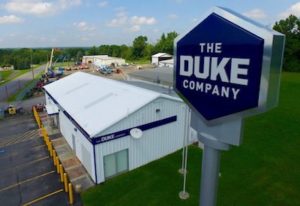 Ithaca: (607) 347-4455
Ithaca: (607) 347-4455
• Hours: Monday – Friday from 7 am – 5 pm EST.
• Address: 7 Hall Road, Ithaca NY 14850
 Dansville: (585) 335-5970
Dansville: (585) 335-5970
• Hours: Monday – Friday from 7 am – 5 pm EST.
• Address: 10131 Poags Hole Road, Dansville, NY 14437
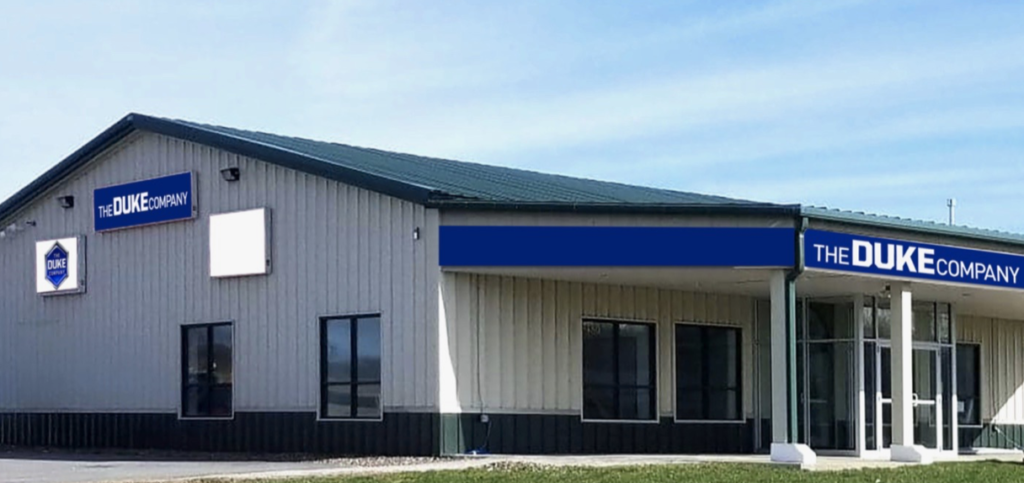 Auburn: (315) 515-3600
Auburn: (315) 515-3600
• Hours: Monday – Friday from 7 am – 5 pm EST.
• Address:480 Grant Avenue, Auburn, NY 13021
